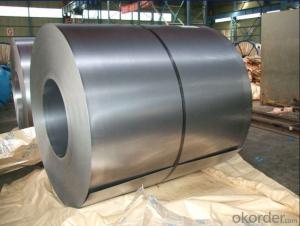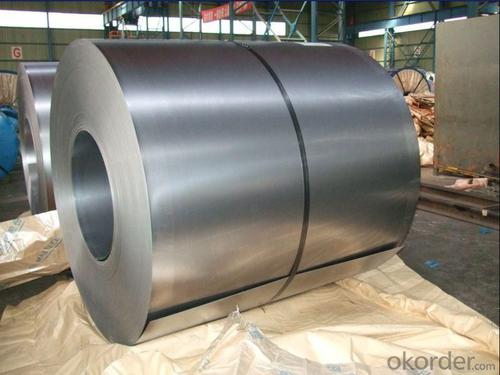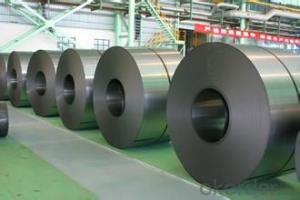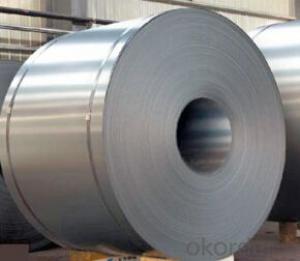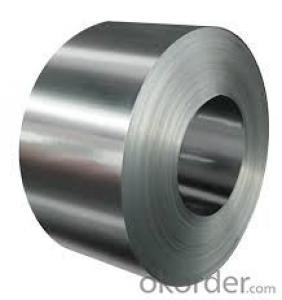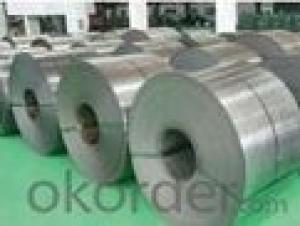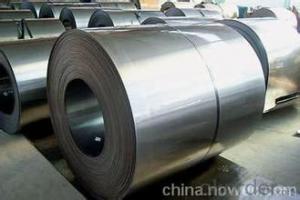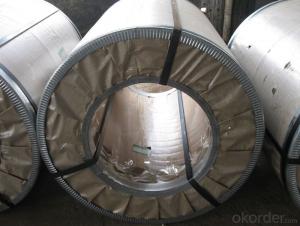First Class Cold Roll Based Steel Sheet Coil
- Loading Port:
- Shanghai
- Payment Terms:
- TT OR LC
- Min Order Qty:
- 60 m.t.
- Supply Capability:
- 8000 m.t./month
OKorder Service Pledge
OKorder Financial Service
You Might Also Like
Product Name | Cold Rolled Sheet Coil |
Material | SPCC/SPCD/SPCE/DC01/ST12/ ST14/SPCD/DC03/DC04 ect. |
Grade Standard | JIS G3302, EN10142, ASTM653, ASTM95 |
Thickness | 0.15-3.5mm |
Width | 600mm-1500mm |
Coil ID | 508-610mm |
Coil OD | max 1500mm |
Weight | 3-10 Tons |
Tolerance | Thickness tolerance:+/-0.02mm; Width tolerance:+/-5mm |
Surface | No-skin passed or Skin passed, Tensile leveled |
Surface Treatment | Chromate/Unchromate passivation, fingerprint resistant treatment, oiled/unoiled |
Annual Output | 350,000MT |
Application | Construction, hardware, home applicances, interior decoration |
General Application of Cold Rolled Steel Coil:
Classification | Designation | Characteristics | Main applications |
Commercial quality | SPCC SPCCT | Commercial quality suitable for bending fabrication and simple forming; this is the type in greatest demand. | Refrigerators, cabinets, power distribution baords and drums. |
Drawing quality | SPCD | Drawing quality second only to that of SPCEN. Excellent uniformity. | Automobile floor and roof panels. |
Deep-drawing quality | SPCE SPCF | Deep-drawing quality.With metallurgically controlled grain size, it retains its beautiful finish even after being deep-drawn. | Automobile fenders and quarter panels |
Extra deep-drawing quality | SPCG | Extra-low-carbon steel sheets with highest workability | Automobile internal panels and deep-drawn parts |
Production Flow Chart
Specification
1. Thickness: 0.4-2.0mm
2. Width: 900-1250mm
3. Inner Diameter: 508 & 610mm
4. Weight of Steel Coil: 3-15MT
5. Heat Treatment: Annealed + Smoothed
6. Margin Status: EC & EM
7. Surface Quality: FC & FD
8. Surface Treatment: Oiling
9. Surface Status: Bright
Chemical Components
Grade | Chemical Components | ||||
C | Mn | P | S | Alt | |
St12 | ≤0.10 | ≤0.50 | ≤0.035 | ≤0.025 | ≥0.020 |
St13 | ≤0.08 | ≤0.45 | ≤0.030 | ≤0.025 | ≥0.020 |
St14 | ≤0.08 | ≤0.40 | ≤0.025 | ≤0.020 | ≥0.020 |
Mechanical Properties
1. Yield Strength: ≤320MPa
2. Tensile Strength: ≤370MPa
3. Elongation (L=50mm, b=25mm) When:
(1) Nominal Thickness <0.25mm: 30%
(2) Nominal Thickness 0.25mm-<0.40: 32%
(3) Nominal Thickness 0.40-<0.60mm: 34%
(4) Nominal Thickness 0.60-<1.0mm: 36%
(5) Nominal Thickness 1.0-<1.6mm: 37%
(6) Nominal Thickness >1.6mm: 38%
- Q: How do steel coils compare to other materials in terms of cost?
- Compared to other materials, steel coils offer greater cost-effectiveness. This is due to the fact that steel is widely accessible and abundant, leading to relatively low production costs. Moreover, steel coils boast an extended lifespan and require minimal upkeep, resulting in reduced expenses over time. The exceptional durability and strength of steel also make it an optimal selection for a wide range of applications, further augmenting its cost-effectiveness. When contrasted with materials such as aluminum or copper, steel coils are typically more economical, making them the preferred option for numerous industries.
- Q: How is the thickness of a steel coil measured?
- The thickness of a steel coil is typically measured using a device called a thickness gauge or micrometer. This tool consists of a calibrated mechanical or digital system that measures the distance between two opposing surfaces of the steel coil. By placing the gauge on the coil and applying pressure, the thickness can be accurately determined.
- Q: How are steel coils used in the production of electrical conduits?
- Several techniques are employed in the production of electrical conduits using steel coils. Firstly, the raw material for manufacturing electrical conduits is steel coils. These coils are composed of specially processed and formed high-quality steel, which is transformed into a continuous strip of considerable length. Once the steel coils are acquired, they are fed into a machine known as a slitter. This machine swiftly slices the coils into narrower strips of the desired width, which will function as the foundational material for the electrical conduits. The subsequent step involves shaping the steel strips into the desired conduit shape. This is accomplished by guiding the strips through a series of rollers and various shaping tools. Gradually, the steel strips take on the round or rectangular shape of the conduit as the rollers exert pressure and manipulate the strip until it reaches the desired form. After the shaping process, the ends of the steel strips are fused together to create a seamless conduit. This welding procedure ensures that the conduit possesses a structure devoid of any seams, a vital characteristic for its functionality and durability. Once the conduits have been shaped and welded, they undergo additional processing to enhance their properties. This may involve galvanizing, whereby a protective layer of zinc is applied to the conduits to shield them from corrosion. This additional layer significantly prolongs the lifespan of the conduits, rendering them suitable for a wide range of electrical applications. In summary, steel coils play a crucial role in the production of electrical conduits. These coils serve as the raw material that is shaped, welded, and further processed to create the final product. The utilization of steel coils ensures that the electrical conduits are robust, long-lasting, and capable of withstanding the rigorous demands of electrical installations.
- Q: What are the different coil slitting line configurations used for steel coils?
- Manufacturers have a range of options when it comes to coil slitting line configurations for steel coils. Each configuration has its own advantages and applications. These configurations are as follows: 1. Simplex Slitting Line: This configuration is suitable for lower production volumes and thinner gauge materials. It utilizes a single slitter head to cut the coil into smaller widths. 2. Loop Slitting Line: Ideal for high-volume production and thicker gauge materials, this configuration features a loop pit that allows for continuous processing without stopping the line. 3. Double Loop Slitting Line: Similar to the loop slitting line, this configuration includes two loop pits, enhancing the line's efficiency and productivity. It is commonly used for processing wider width and thicker gauge materials. 4. Tension Stand Slitting Line: With a tension stand that applies constant tension during the slitting process, this configuration ensures consistent slit widths. It is often used for high-precision slitting applications. 5. Rotary Shear Slitting Line: This configuration utilizes a rotary shear to cut the steel coil into smaller widths. It is suitable for both thin and thick gauges and offers high-speed and accurate cutting. 6. Scrap Winder Slitting Line: This configuration incorporates a scrap winder to collect excess material trimmed during the slitting process. It helps improve efficiency and reduces waste. 7. Combination Slitting Line: Combining multiple slitting processes into a single line, this configuration allows for different slitting methods and widths to be achieved within one setup. It provides flexibility and versatility in processing various steel coil sizes and materials. Manufacturers can choose from these different coil slitting line configurations based on their specific production requirements and the properties of the steel coils they are processing.
- Q: What are the quality standards for steel coil production?
- The quality standards for steel coil production typically include factors such as dimensional accuracy, surface finish, mechanical properties, chemical composition, and adherence to industry-specific standards and specifications. These standards ensure that the steel coils meet the required strength, durability, and performance criteria, and are suitable for various applications in industries like automotive, construction, and manufacturing.
- Q: I have my grandpa's navy knife from ww2, a mk2 combat knife i think, and i was wondering what type of steel it is made of. I'm guessing it's a high carbon steel, i'd just like to know exactly what grade.
- I would get a 1095, serrated edge, tanto style, with either a good quality rubberized or bone handle.
- Q: How are steel coils protected against corrosion?
- Steel coils are protected against corrosion through various methods such as applying protective coatings like zinc, aluminum, or polymer, or using a process called galvanization where the coils are coated with a layer of zinc. Additionally, storing the coils in a controlled environment with low humidity and proper ventilation also helps prevent corrosion.
- Q: Hey Guys, I'm planning on purchasing a bmx bike and I have been recommended by many people the Kink Launch 2012. I'm thinking of getting it but the frame is made from High Tensile steel and I know the chromoly is stronger and more expensive, but I plan to use my bmx just to chill, ride with friends and some times go through dirt trails at my park, I would like to know, how strong Hi Tensile steel is and can it handle jumps not massive jumps but like jumps where you get like 3 feet high (1m) just for fun, I might go to the skate park but I'm not gonna do tail whips and massive jumps, I just want it as a mobile piece of transportation. I don't want to buy a mtb because I already had 3 of them and they are not practical to take with you on holidays.So, do you think the Kink Launch 2012 is good enough or should I cough up an extra $80 and get the gap ($500 AU)? As I said I ain't gonna do huge jumps.
- High tensile steel could mean almost anything. SAE 4130 Chrome-Moly steel is the de-facto standard for steel bikes frames. High tensile steel could actually mean the same thing since chrome-moly is classified as high strength steel. The strength of the frame depends as much on the quality of the welds and on the size/thickness of the tubing as much as anything else. I'd say what kind of steel you use makes only a minor difference. One reason you want to buy bikes from reputable name-brand companies is they tend to have strict quality controls, this is particularly important when it comes to welds. Welds are always the weakest part of any bike frame, don't let anyone tell you different. 99% of the time if something in the frame breaks, it'll be at the welds. hope this helps.
- Q: How do steel coils contribute to earthquake resistance in structures?
- Steel coils contribute to earthquake resistance in structures by providing strength and flexibility. When used as reinforcement in concrete structures, steel coils help to distribute and dissipate the energy generated during an earthquake. This helps to prevent the excessive deformation or collapse of the structure, enhancing its overall seismic performance. Steel coils also improve the ductility of the structure, allowing it to withstand the dynamic forces and vibrations caused by seismic activity.
- Q: Can i make holes in iron and steel with somekind of drill bit. All i have is metal drill bits. Mabey like 68 of them but i dont know wich one to use and if they will penetrate.
- If a drill bit will not do the job, you will have to go to something like EDM. But that is a lot of trouble, ask a machinist first.
Send your message to us
First Class Cold Roll Based Steel Sheet Coil
- Loading Port:
- Shanghai
- Payment Terms:
- TT OR LC
- Min Order Qty:
- 60 m.t.
- Supply Capability:
- 8000 m.t./month
OKorder Service Pledge
OKorder Financial Service
Similar products
Hot products
Hot Searches
Related keywords
